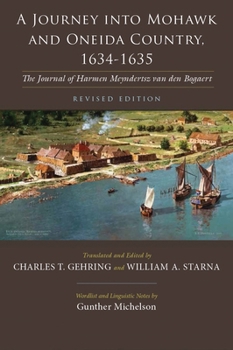A Journey Into Mohawk and Oneida Country, 1634-1635: The Journal of Harmen Meyndertsz Van Den Bogaert, Revised Edition
Select Format
Select Condition 
Book Overview
In 1634, the Dutch West India Company was anxious to know why the fur trade from New Netherland had been declining, so the company sent three employees far into Iroquois country to investigate. Harmen Meyndertsz van den Bogaert led the expedition from Fort Orange (present-day Albany, NY). His is the earliest known description of the interior of what is today New York State and its seventeenth-century native inhabitants. Van den Bogaert was a keen observer, and his journal is not only a daily log of where the expedition party traveled; it is also a detailed account of the Mohawks and the Oneidas: the settlements, modes of subsistence, and healing rituals. Van den Bogaert's extraordinary wordlist is the earliest known recorded vocabulary of the Mohawk language. Gehring's translation and Starna's annotations provide indispensable material for anthropologists, ethnohistorians, linguists, and anyone with a special interest in Native American studies. Michelson's current additions to the wordlist of Mohawk equivalents with English glosses (wherever possible) and his expert analysis of the language in the Native American passages offer a valuable new dimension to this edition of the journal.
Format:Paperback
Language:English
ISBN:081563322X
ISBN13:9780815633228
Release Date:April 2013
Publisher:Syracuse University Press
Length:160 Pages
Weight:0.50 lbs.
Dimensions:0.4" x 5.6" x 8.0"
Customer Reviews
1 rating
sparse text
Published by Thriftbooks.com User , 15 years ago
This text is rather sparse, so would probably not be of much interest to the general reader. But then, the general reader would probably not even be looking at this title. If, like me, you find yourself fascinated with first person accounts of early European contacts with Native Americans, this is valuable simply because there are so few surviving accounts from the New Netherlands era. This is the diary of a mid-winter journey through the upper Mohawk Valley. Well footnoted and with a large glossary of Mohawk words.






